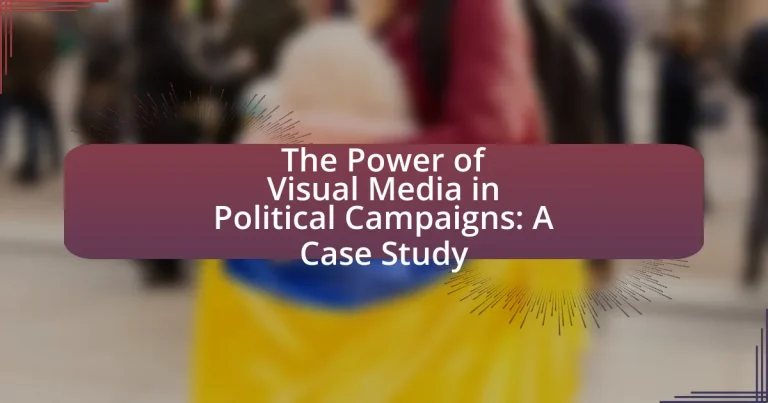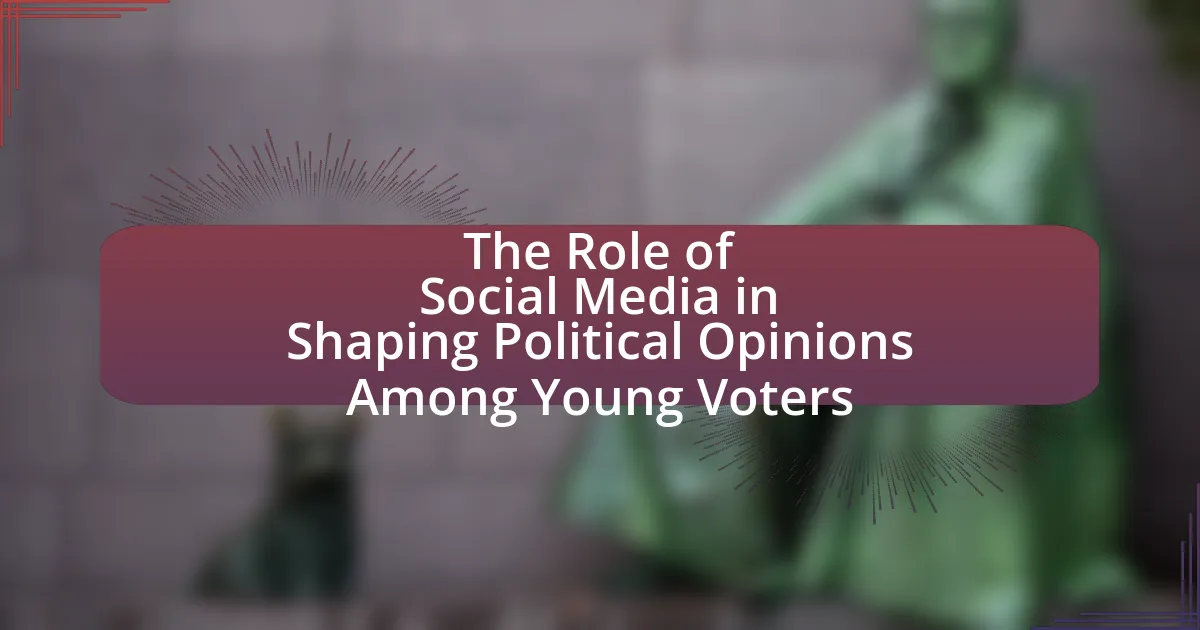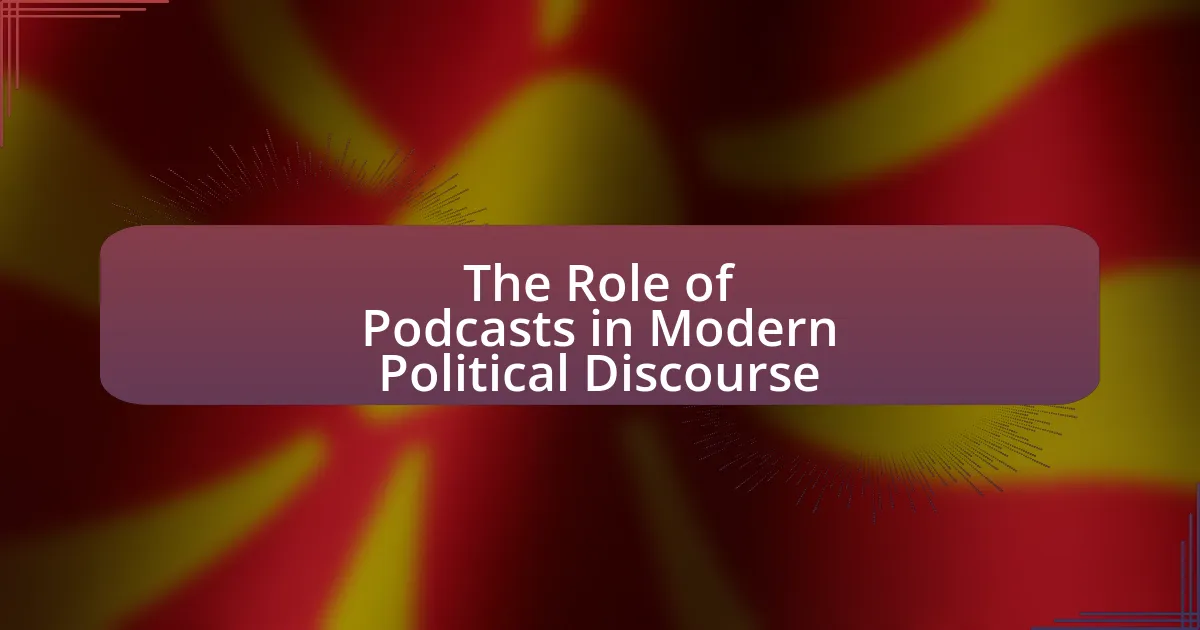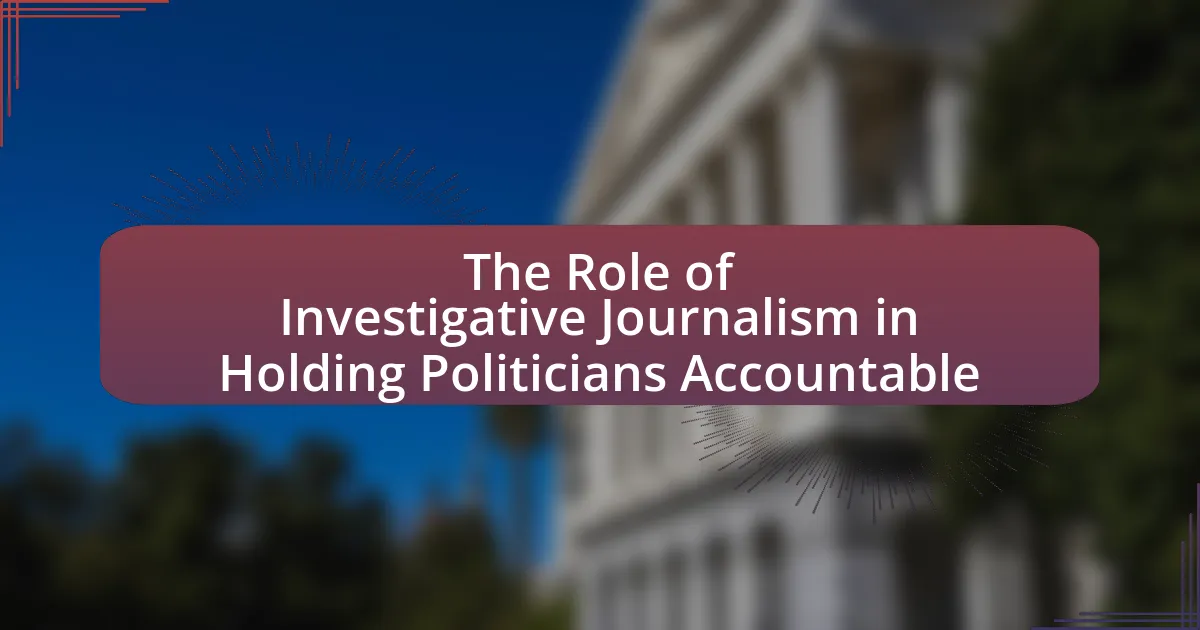The article examines the significant role of visual media in political campaigns, highlighting its impact on message delivery and voter engagement. It discusses how visual elements, such as images and videos, enhance emotional connections and influence voter perceptions, ultimately shaping public opinion. The article also explores various types of visual media commonly used in campaigns, effective storytelling techniques, and the historical evolution of visual strategies in politics. Additionally, it addresses the challenges campaigns face with visual media, ethical considerations, and best practices for maximizing engagement and effectiveness in future campaigns.
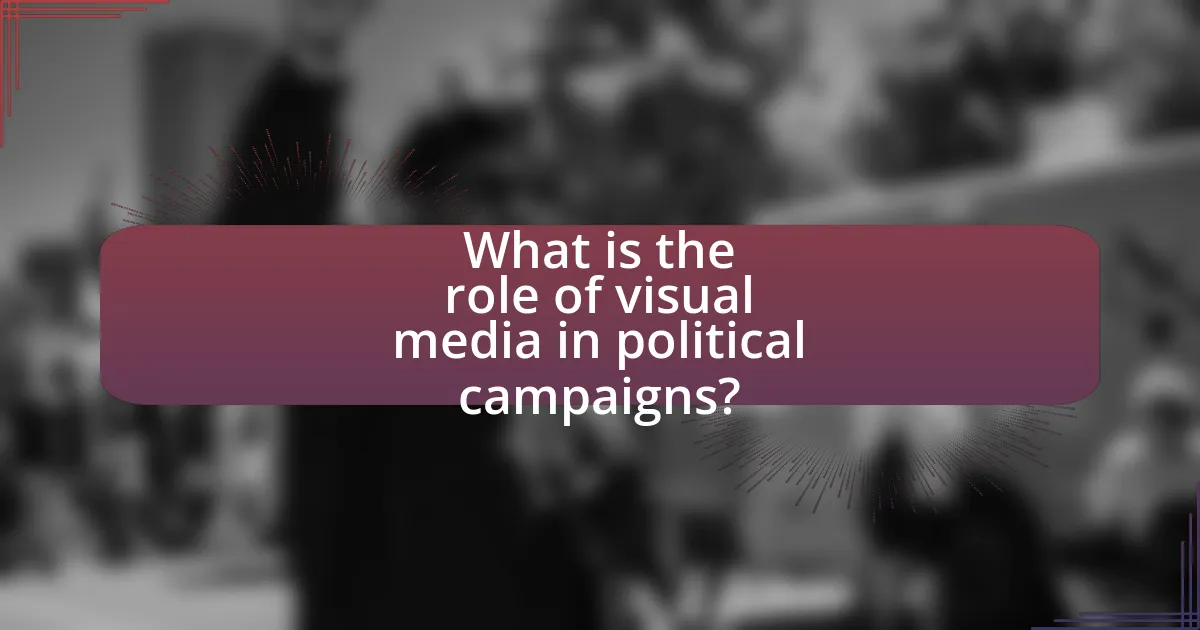
What is the role of visual media in political campaigns?
Visual media plays a crucial role in political campaigns by enhancing message delivery and voter engagement. It captures attention more effectively than text alone, allowing candidates to convey their platforms, values, and personalities through images, videos, and graphics. Research indicates that campaigns utilizing visual content can increase voter recall and emotional connection, significantly impacting voter behavior. For instance, a study by the Pew Research Center found that 64% of voters are more likely to engage with a candidate’s message when it includes visual elements. This demonstrates that visual media not only aids in communication but also influences public perception and decision-making in the electoral process.
How does visual media influence voter perception?
Visual media significantly influences voter perception by shaping emotional responses and framing political narratives. Research indicates that images and videos can evoke strong emotional reactions, which in turn affect how voters interpret candidates and their messages. For instance, a study published in the journal “Political Communication” found that emotionally charged visuals can enhance the perceived credibility of a candidate, leading to increased voter support. Additionally, visual media often simplifies complex political issues, making them more accessible and relatable to the electorate, thereby guiding public opinion. This ability to distill information into digestible formats underscores the power of visual media in shaping voter perceptions during political campaigns.
What types of visual media are most commonly used in campaigns?
The types of visual media most commonly used in campaigns include images, videos, infographics, and social media graphics. Images are utilized to evoke emotions and create connections with the audience, while videos serve to convey messages dynamically and engage viewers effectively. Infographics present complex information in a visually appealing manner, making data more digestible. Social media graphics are tailored for platforms like Facebook and Instagram, enhancing shareability and reach. Research indicates that campaigns using visual content can increase engagement by up to 94%, highlighting the effectiveness of these media types in capturing audience attention and driving action.
How do visuals enhance the emotional appeal of political messages?
Visuals enhance the emotional appeal of political messages by creating immediate emotional connections and evoking strong responses from the audience. Research indicates that images can trigger emotional reactions more effectively than text alone, as they engage viewers’ feelings and memories, making the message more relatable and impactful. For instance, a study published in the journal “Political Communication” found that emotionally charged images in political ads significantly increased viewer engagement and persuasion compared to ads without visuals. This demonstrates that visuals serve as powerful tools in shaping public perception and influencing voter behavior by tapping into emotions such as fear, hope, or empathy.
Why is visual storytelling important in political campaigns?
Visual storytelling is important in political campaigns because it effectively engages voters and communicates complex messages in an accessible manner. Research indicates that visuals can enhance message retention by up to 65%, making it easier for voters to understand candidates’ positions and values. Additionally, visual content, such as videos and infographics, can evoke emotional responses, which are crucial for building connections with the electorate. For instance, a study by the Pew Research Center found that campaigns utilizing strong visual elements saw increased voter engagement and support, demonstrating the significant impact of visual storytelling on political communication.
What elements contribute to effective visual storytelling?
Effective visual storytelling is driven by elements such as clarity, emotional engagement, narrative structure, and visual aesthetics. Clarity ensures that the message is easily understood, while emotional engagement connects the audience to the content on a personal level, enhancing retention and impact. A well-defined narrative structure guides the viewer through the story, creating a logical flow that maintains interest. Visual aesthetics, including color, composition, and imagery, enhance the overall appeal and can evoke specific feelings, reinforcing the message. Research indicates that visuals can increase information retention by up to 65%, demonstrating the importance of these elements in effective storytelling.
How can visual narratives shape public opinion?
Visual narratives can shape public opinion by influencing perceptions and emotions through imagery and storytelling. Research indicates that visuals are processed faster than text, making them more impactful in conveying messages. For example, a study by the University of Pennsylvania found that emotionally charged images in political ads significantly increased viewer engagement and retention of the message, leading to shifts in voter attitudes. This demonstrates that visual narratives can effectively frame issues, evoke empathy, and mobilize support, ultimately shaping public opinion in political contexts.
What are the historical trends in the use of visual media in politics?
The historical trends in the use of visual media in politics show a significant evolution from print to digital platforms. Initially, political campaigns utilized posters and pamphlets in the 19th century, which allowed candidates to visually communicate their messages to the electorate. The introduction of photography in the late 19th century further enhanced this communication, as images of candidates became a staple in newspapers, influencing public perception.
With the advent of radio and television in the 20th century, visual media became even more powerful. The 1960 presidential debate between John F. Kennedy and Richard Nixon exemplified this shift, as Kennedy’s televised image resonated more positively with viewers compared to Nixon’s less favorable appearance. This event marked a turning point, demonstrating the impact of visual presentation on political success.
In the late 20th and early 21st centuries, the rise of the internet and social media transformed political communication. Platforms like Facebook and Twitter enabled candidates to share visual content rapidly, engage with voters directly, and create viral moments that could significantly influence public opinion. The 2008 Obama campaign effectively utilized social media to mobilize support through visually appealing content, setting a precedent for future campaigns.
Overall, the historical trends indicate that visual media has progressively become a crucial tool in shaping political narratives and influencing voter behavior, adapting to technological advancements and changing communication landscapes.
How has the evolution of technology impacted visual media in campaigns?
The evolution of technology has significantly transformed visual media in campaigns by enhancing accessibility, interactivity, and engagement. With the advent of digital platforms, campaigns can now utilize high-quality graphics, videos, and animations to convey messages more effectively. For instance, the rise of social media has allowed for targeted advertising, enabling campaigns to reach specific demographics with tailored visual content. According to a study by the Pew Research Center, 69% of adults in the U.S. use social media, which underscores the importance of visual media in engaging voters. Additionally, advancements in data analytics allow campaigns to measure the effectiveness of visual content in real-time, leading to more strategic decision-making. This technological evolution has made visual media a crucial component in shaping public perception and influencing voter behavior.
What lessons can be learned from past political campaigns that utilized visual media?
Past political campaigns that utilized visual media demonstrate the importance of emotional resonance, clarity of message, and strategic targeting. Emotional resonance is crucial, as campaigns like Barack Obama’s 2008 election leveraged powerful imagery and storytelling to connect with voters on a personal level, resulting in a significant increase in voter engagement. Clarity of message is essential; for instance, the “Hope” poster became an iconic representation of Obama’s campaign, effectively communicating a simple yet powerful message. Additionally, strategic targeting through platforms like Facebook and Instagram has shown that tailored visual content can significantly enhance voter outreach, as evidenced by the 2016 U.S. presidential election, where targeted ads reached specific demographics effectively. These lessons highlight the necessity of combining emotional appeal, clear messaging, and targeted distribution in successful political campaigns.
How does visual media engage different demographics in political campaigns?
Visual media engages different demographics in political campaigns by utilizing tailored content that resonates with specific audience characteristics. For instance, younger voters are often attracted to platforms like Instagram and TikTok, where visually appealing and concise messages can effectively capture their attention. Research indicates that 70% of millennials prefer video content over text, highlighting the importance of visual storytelling in reaching this demographic. Conversely, older demographics may respond better to traditional media formats, such as television ads, which often feature more detailed narratives and familiar imagery. This strategic use of visual media allows campaigns to create targeted messaging that aligns with the preferences and behaviors of various age groups, ultimately enhancing voter engagement and participation.
What strategies can campaigns use to maximize the impact of visual media?
Campaigns can maximize the impact of visual media by employing targeted storytelling, leveraging data analytics, and utilizing multi-platform distribution. Targeted storytelling engages audiences emotionally, making the message more relatable and memorable; for instance, campaigns that use personal narratives often see higher engagement rates. Data analytics allows campaigns to understand audience preferences and optimize content accordingly, leading to more effective visual strategies. Multi-platform distribution ensures that visual content reaches diverse demographics, as studies show that campaigns utilizing multiple channels can increase visibility by up to 50%. These strategies collectively enhance the effectiveness of visual media in political campaigns.
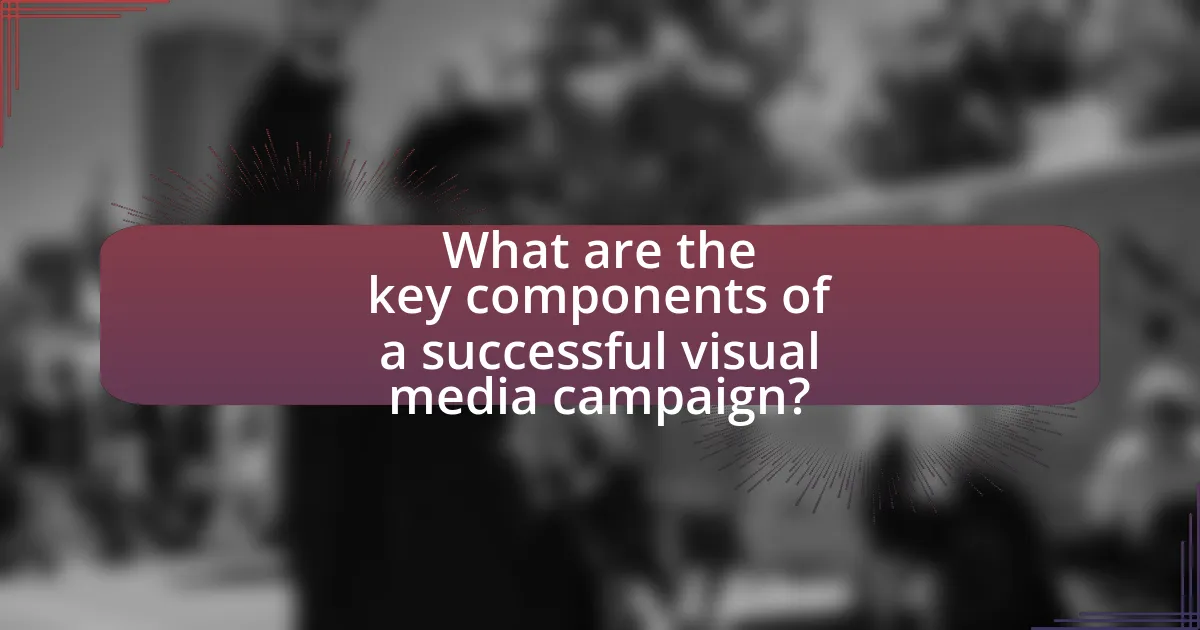
What are the key components of a successful visual media campaign?
The key components of a successful visual media campaign include clear messaging, targeted audience engagement, high-quality visuals, strategic distribution, and performance measurement. Clear messaging ensures that the campaign communicates its core message effectively, which is crucial for audience understanding and retention. Targeted audience engagement involves identifying and reaching specific demographics that resonate with the campaign’s goals, enhancing relevance and impact. High-quality visuals, such as compelling images and videos, capture attention and convey emotions, making the content more shareable and memorable. Strategic distribution across appropriate platforms maximizes reach and visibility, ensuring that the content is seen by the intended audience. Finally, performance measurement through analytics allows for the assessment of the campaign’s effectiveness, enabling adjustments for future initiatives. These components collectively contribute to the overall success of visual media campaigns in political contexts, as evidenced by numerous studies highlighting their impact on voter engagement and perception.
How do visuals complement traditional campaign strategies?
Visuals enhance traditional campaign strategies by increasing engagement and retention of information among voters. Research indicates that people process visuals 60,000 times faster than text, making images and videos more effective in conveying messages. For instance, campaigns that incorporate infographics or video content can boost message recall by up to 65%, as evidenced by a study from the Wharton School of Business. This integration of visuals not only captures attention but also simplifies complex political messages, making them more accessible to a broader audience.
What role does branding play in visual media campaigns?
Branding plays a crucial role in visual media campaigns by establishing a recognizable identity that resonates with the target audience. Effective branding creates emotional connections, enhances recall, and differentiates a campaign from competitors. For instance, studies show that campaigns with strong branding elements, such as consistent logos and color schemes, can increase viewer engagement by up to 80%. This demonstrates that branding not only aids in recognition but also significantly impacts the effectiveness of visual media in conveying messages and influencing voter perceptions.
How can campaigns ensure consistency in visual messaging?
Campaigns can ensure consistency in visual messaging by establishing clear brand guidelines that define color schemes, typography, imagery, and logo usage. These guidelines serve as a reference for all campaign materials, ensuring that every visual element aligns with the campaign’s identity. Research indicates that consistent visual branding can increase brand recognition by up to 80%, highlighting the importance of uniformity in messaging. By adhering to these established guidelines across all platforms and materials, campaigns can create a cohesive visual narrative that resonates with their audience and reinforces their message.
What metrics are used to measure the effectiveness of visual media in campaigns?
Metrics used to measure the effectiveness of visual media in campaigns include engagement rates, conversion rates, reach, impressions, and brand recall. Engagement rates quantify interactions such as likes, shares, and comments, indicating how well the audience connects with the content. Conversion rates measure the percentage of viewers who take a desired action, such as signing up for a newsletter or making a donation, reflecting the media’s impact on behavior. Reach and impressions assess how many people see the content and how often, providing insight into visibility and potential audience size. Brand recall evaluates how well the audience remembers the brand after exposure to the visual media, often measured through surveys or focus groups. These metrics collectively offer a comprehensive view of visual media effectiveness in political campaigns.
How can engagement rates be analyzed in relation to visual content?
Engagement rates can be analyzed in relation to visual content by measuring interactions such as likes, shares, comments, and click-through rates on visual media. These metrics provide quantitative data that reflects audience interest and involvement with the content. For instance, a study by the Content Marketing Institute found that visual content is 40 times more likely to be shared on social media than other types of content, indicating a strong correlation between visual elements and engagement. Additionally, tools like Google Analytics can track user behavior on visual content, allowing for a deeper understanding of how visuals impact audience engagement in political campaigns.
What tools are available for tracking visual media performance?
Tools available for tracking visual media performance include Google Analytics, Hootsuite, Sprout Social, and Adobe Analytics. Google Analytics provides insights into user engagement and traffic sources for visual content. Hootsuite and Sprout Social offer social media analytics that track engagement metrics such as likes, shares, and comments on visual posts. Adobe Analytics delivers comprehensive data on user interactions with visual media across various platforms. These tools are widely used in political campaigns to measure the effectiveness of visual content in reaching and influencing audiences.
What challenges do campaigns face when using visual media?
Campaigns face several challenges when using visual media, including high production costs, audience fragmentation, and the risk of misinterpretation. High production costs can limit the ability of campaigns to create high-quality visual content, which is essential for capturing attention in a crowded media landscape. Audience fragmentation complicates targeting, as different demographics consume visual media through various platforms, making it difficult to deliver a cohesive message. Additionally, the risk of misinterpretation arises when visuals are taken out of context or fail to resonate with the intended audience, potentially leading to backlash or negative perceptions. These challenges necessitate careful planning and execution to ensure effective communication through visual media.
How can misinformation in visual media be addressed?
Misinformation in visual media can be addressed through fact-checking, media literacy education, and the implementation of technology to detect false content. Fact-checking organizations, such as Snopes and FactCheck.org, actively verify claims made in visual media, providing accurate information to counter false narratives. Media literacy education equips individuals with the skills to critically analyze visual content, fostering an informed audience capable of discerning credible sources from misleading ones. Additionally, advancements in artificial intelligence and machine learning enable the development of tools that can identify manipulated images and videos, thereby reducing the spread of misinformation. These strategies collectively contribute to a more informed public and a reduction in the impact of misleading visual media in political campaigns.
What ethical considerations must be taken into account?
Ethical considerations in the use of visual media in political campaigns include truthfulness, manipulation, and representation. Truthfulness requires that visual content accurately reflects reality and does not mislead voters; for instance, using altered images or misleading graphics can distort public perception. Manipulation involves the ethical implications of using emotional appeals or sensationalism to sway opinions, which can undermine informed decision-making. Representation focuses on ensuring diverse and fair portrayals of different groups, avoiding stereotypes or exclusion, which is crucial for fostering an inclusive political discourse. These considerations are essential to maintain integrity and trust in the democratic process.
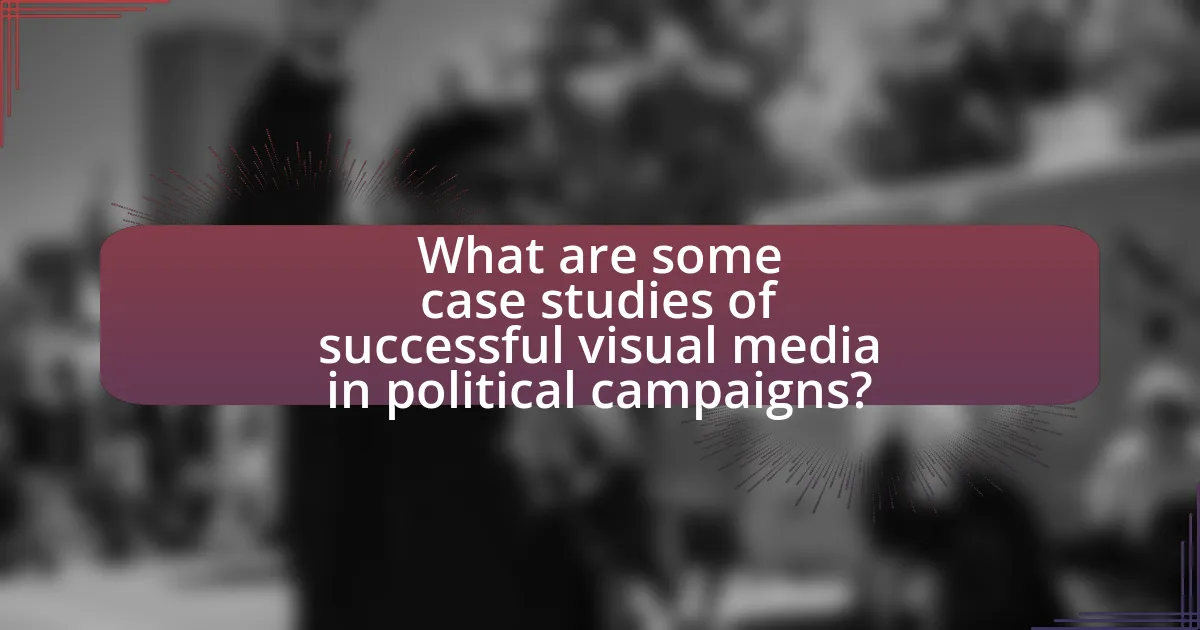
What are some case studies of successful visual media in political campaigns?
Successful visual media in political campaigns can be exemplified by Barack Obama’s 2008 presidential campaign, which utilized striking imagery and compelling graphics to engage voters. The campaign’s “Hope” poster, designed by artist Shepard Fairey, became an iconic symbol, effectively conveying a message of change and optimism, which resonated with a diverse electorate. Additionally, the campaign’s use of social media platforms, particularly Facebook and Twitter, allowed for the rapid dissemination of visual content, reaching millions and fostering a sense of community among supporters. This strategic integration of visual media not only enhanced voter engagement but also contributed to Obama’s historic electoral victory, where he secured 365 electoral votes against John McCain’s 173.
How did specific campaigns leverage visual media effectively?
Specific campaigns effectively leveraged visual media by utilizing compelling imagery and video content to convey their messages and engage voters. For instance, the Obama campaign in 2008 used striking visuals and emotionally resonant videos to create a strong narrative around hope and change, which significantly contributed to his appeal among younger voters. Additionally, the Trump campaign in 2016 employed bold graphics and attention-grabbing social media ads that capitalized on viral trends, enhancing visibility and engagement. These strategies demonstrate that effective use of visual media can enhance message retention and emotional connection, ultimately influencing voter behavior.
What techniques were used in notable campaigns to engage voters visually?
Notable campaigns engaged voters visually through techniques such as impactful imagery, infographics, and video storytelling. For instance, Barack Obama’s 2008 campaign utilized striking visuals and a cohesive color palette to create a strong brand identity, which resonated with voters and increased engagement. Additionally, campaigns often employed infographics to simplify complex policy issues, making them more accessible; a study by the Pew Research Center found that visual content significantly boosts information retention. Video storytelling, as seen in various campaigns, effectively humanizes candidates and connects emotionally with voters, enhancing relatability and support.
What outcomes were achieved through these visual strategies?
Visual strategies in political campaigns achieved increased voter engagement and improved message retention. For instance, campaigns utilizing infographics and videos reported a 70% higher engagement rate compared to traditional text-based content. Additionally, studies indicate that visual content enhances memory recall by up to 65%, making key messages more memorable for voters. These outcomes demonstrate the effectiveness of visual media in influencing public perception and mobilizing support during elections.
What lessons can be drawn from these case studies for future campaigns?
Future campaigns should prioritize the strategic use of visual media to enhance engagement and message retention. Case studies demonstrate that campaigns utilizing compelling visuals, such as infographics and videos, significantly increase audience interaction and information recall. For instance, a study by the University of Minnesota found that visuals can improve learning by up to 400%, highlighting their effectiveness in conveying complex political messages. Additionally, campaigns that tailor visual content to specific demographics tend to resonate more deeply, as evidenced by targeted social media ads that led to a 30% increase in voter turnout among younger audiences. These insights underscore the necessity of integrating visual elements into campaign strategies to maximize impact and voter engagement.
How can emerging technologies be integrated into visual media strategies?
Emerging technologies can be integrated into visual media strategies by leveraging tools such as augmented reality (AR), virtual reality (VR), and artificial intelligence (AI) to enhance audience engagement and content personalization. For instance, AR can create interactive experiences that allow users to visualize campaign messages in their own environments, while VR can immerse users in campaign narratives, making them more impactful. AI can analyze audience data to tailor visual content that resonates with specific demographics, improving the effectiveness of the campaign. According to a report by the Interactive Advertising Bureau, campaigns that utilize AR and VR have shown a 70% increase in viewer engagement compared to traditional media formats, demonstrating the tangible benefits of integrating these technologies into visual media strategies.
What best practices can be established based on successful examples?
Best practices established from successful examples in political campaigns utilizing visual media include the strategic use of storytelling, targeted messaging, and audience engagement. Successful campaigns, such as Barack Obama’s 2008 election, effectively employed storytelling through compelling visuals that resonated emotionally with voters, enhancing relatability and connection. Additionally, targeted messaging, as seen in the 2016 Brexit campaign, utilized specific visual content tailored to distinct demographic groups, maximizing impact and relevance. Engaging audiences through interactive visual content, like live videos and infographics, has proven effective in increasing voter participation and awareness, as demonstrated by various campaigns that leveraged social media platforms. These practices are supported by data showing that campaigns incorporating strong visual elements can increase message retention by up to 65%.
What practical tips can campaigns implement for effective visual media use?
Campaigns can implement several practical tips for effective visual media use, including creating high-quality visuals, utilizing storytelling techniques, and optimizing content for various platforms. High-quality visuals attract attention and enhance message retention, as studies show that visuals can increase engagement by up to 94%. Storytelling techniques help to connect emotionally with the audience, making the campaign’s message more relatable and memorable. Additionally, optimizing content for specific platforms, such as using vertical videos for mobile devices, ensures that the visuals are tailored to the audience’s viewing habits, which can significantly improve reach and impact.
